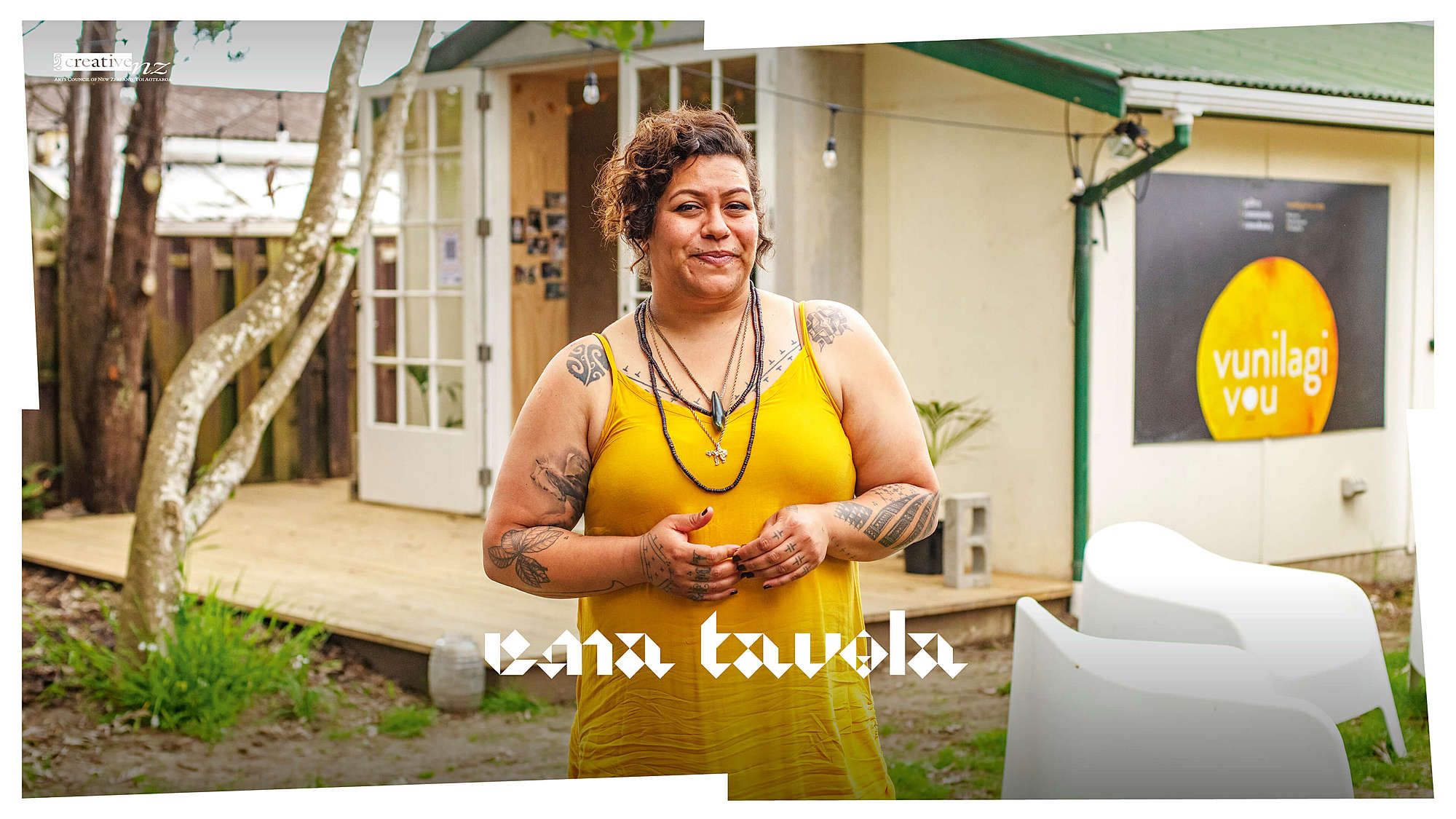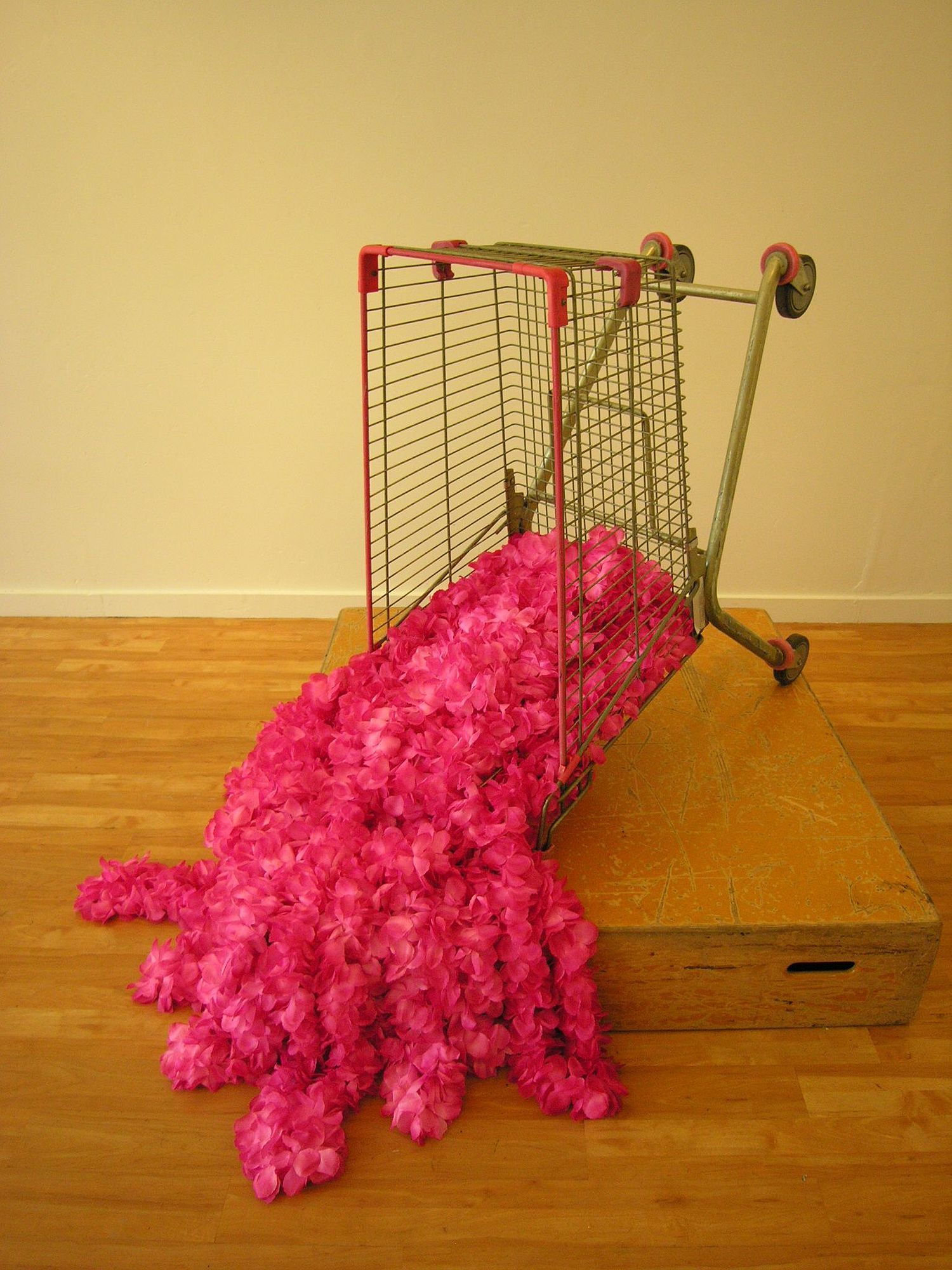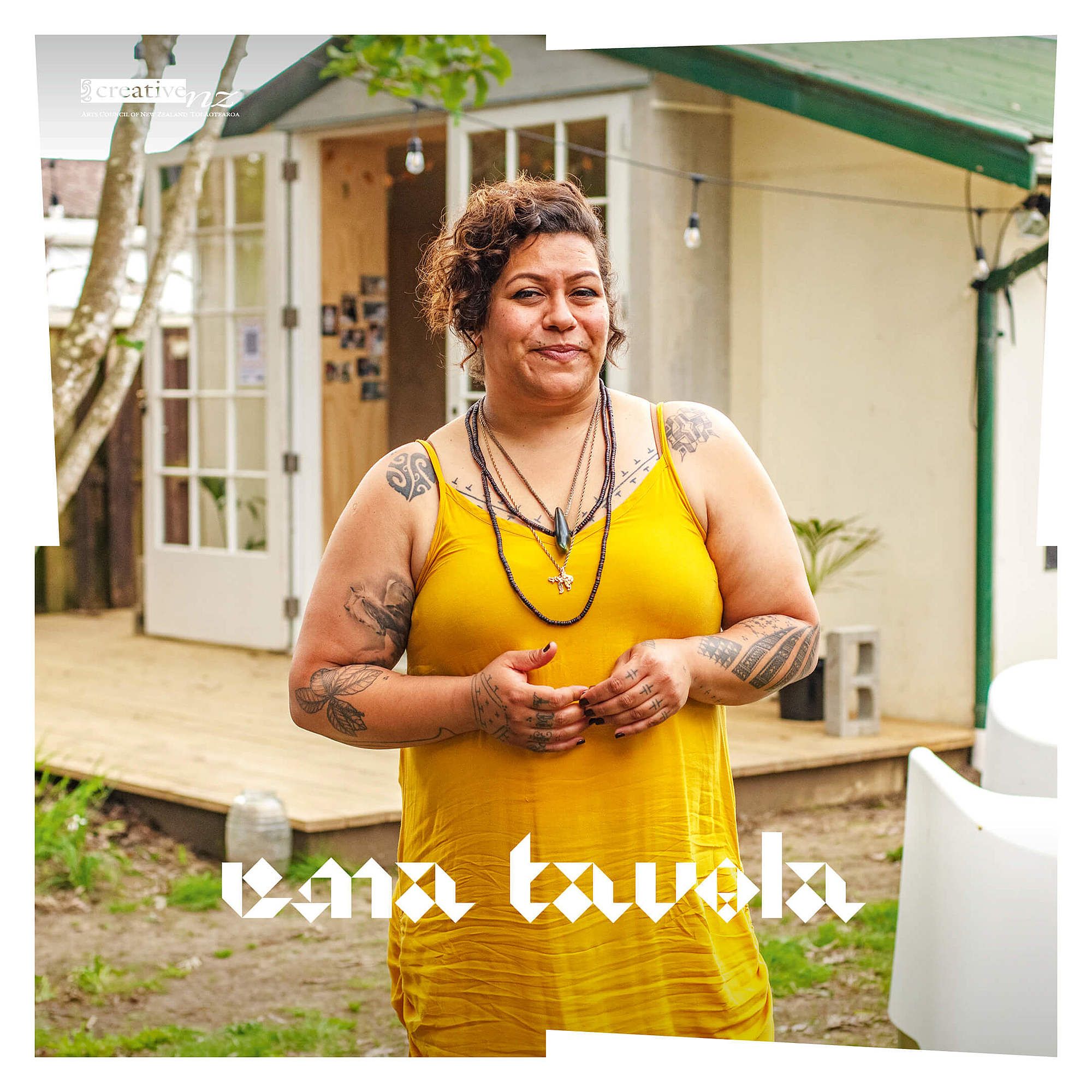The Alchemy of Fresh
Dream of a locally and culturally relevant art gallery, and what does your mind conjure up? Curator Ema Tavola on the magical legacy of Fresh Gallery Ōtara.
We’re collaborating with Creative New Zealand to bring you the groundbreaking Pacific Arts Legacy Project. Curated by Lana Lopesi as project Editor-in-Chief, it’s a foundational history of Pacific arts in Aotearoa as told from the perspective of the artists who were there.
When I applied for the role of Pacific Arts Coordinator for Manukau City Council in 2005, at the end of my Bachelor of Visual Arts studies at Manukau School of Visual Arts (MSVA), I was interviewed by a panel of Māori and Pacific Island women. They weren’t human resources personnel, they were leaders in their fields of arts and community development, within what was, historically, an impressively progressive local-government authority. In my professional career, I’ve come to understand how unique this was, and how much the experience, for better or worse, set my bar incredibly high for representation, leadership and community accountability in the arts.
Manukau City Council’s geographic territory went from the borders of Papatoetoe and Māngere in the north, out east to Pakuranga, Howick and Clevedon, and down to Manurewa in the south. The suburb of Ōtara is flanked on every side, located in the heart of it all. To the outside world, the area known as South Auckland was often characterised by low-socio-economic, working-class communities with high densities of Māori and Pacific Island populations, and all the social issues that come with systemic disadvantage and its adverse conditions. To me, a new 20-something migrant from Fiji via Wellington, Manukau was the closeness I needed to the Pacific, a cultural landscape full of exuberance, colour, joyful laughter, children and intergenerational connectedness. Studying in Ōtara felt like having one foot in the Pacific Islands and one in Aotearoa.
Through Manukau School of Visual Arts’ residency programme, led by the late Paul Cullen, I had the opportunity to work alongside three international artists whose practices firmly centred people. The practices of Amy Plant (UK), Alwin Reamillo (Philippines) and Juan Castillo (Chile) were loosely framed within the genre of social sculpture; they had vested interests in collective practice, participation and process. Their residencies used Ōtara and Manukau to develop site-specific projects inspired in part by the stark social, political and cultural difference between central Auckland, where their accommodation was, and the environment and contexts of MSVA, located in a semi-industrial backroad of suburban Ōtara. For students of MSVA, the residencies enabled connections to the institution’s surrounding communities in ways that the formal curriculum never did. For me, these residency projects formed vital bridges between the world of institutional fine arts and the grassroots communities and spaces where I lived and worked; bridges that were few and far between.
Ōtara TV was a response from a first-time visitor to Aotearoa to the glaringly negative perception of Manukau perpetuated by mainstream media
Amy Plant’s 2004 residency project, Ōtara TV, was a response from a first-time visitor to Aotearoa to the glaringly negative perception of Manukau perpetuated by mainstream media. She invited students to help her produce a video in the style of a television magazine show, highlighting local stories, community-led initiatives and people who worked tirelessly for the Ōtara community. The 30-minute show was screened on Triangle Television and DVD copies were gifted back to the community participants. I was one of two presenters on Ōtara TV and became deeply inspired by a local arts organisation, Wahine Malosi Charitable Trust, which was discussed in an interview with its co-founder, Noma Sio. The organisation had staged a sit-in to occupy an unused council-owned shop premises in the Ōtara Town Centre. Their activism was effective and the space went on to be run as a creative hub called Artnet Gallery, leased to and administered by Wahine Malosi. I began volunteering at Artnet Gallery that year, and it was where I staged my first curatorial project, a joint exhibition of two MSVA painting students, Samiuela Napa’a and Reagan Iosefa Samoa, called The Artists are described as… Polynesian Male.
In 2006, I was employed by Manukau City Council. Artnet Gallery had been closed and Wahine Malosi had shifted its focus to other areas of community development. But having seen first-hand, as a student, the ways this community initiative had served, responded to and impacted local audiences, I was able to build a case for the council to continue the work of Artnet Gallery and Wahine Malosi, and reopen the space as a community gallery.
"MensTrolley Speaking" (2007) from BUY SPEND SAVE NOW, a collaborative exhibition by Shigeyuki Kihara, Leilani Salesa and Ema Tavola, Fresh Gallery Otara, 2007. Photo credit: Naomi Singer.
Fresh Gallery Ōtara was opened as a rebranded council-run facility dedicated to Pacific art and the site-specificity of Ōtara and Manukau on 26 May 2006. The facility’s name was generated out of a meeting of community representatives, who deliberated on about 20 name suggestions submitted through an open call-out. Although a worthy contender was The Henry Wilson Gallery, after a highly respected local artist who had recently passed away, the name Fresh Gallery was selected, submitted by local artist Leilani Kake. Ōtara was added to the name to purposefully locate the space, own it and ensure it could be easily differentiated from numerous similarly titled galleries around the world.
Without an operational budget, Fresh Gallery Ōtara was initially run as an offshoot of Ōtara Music Arts Centre (OMAC), located in the same block of council-owned buildings in the Ōtara Town Centre. In the beginning, there was no budget to support an exhibitions programme, but with a community of local arts students and graduates from MSVA, exhibitions were easily pulled together. Artwork produced for other exhibitions was re-presented, remixed and reconsidered, artists used exhibition timeframes to transform the gallery into a live studio space; exhibitions took on the form of marketplaces and making spaces. Fresh was free to evolve and respond to the community and environment in real time.
It was always the intention for Fresh Gallery Ōtara to showcase the potential of visual arts and create relevant programming to inspire local audiences and demonstrate the ways artists contribute to a shared sense of being and thinking, belonging and evolving. It became clear that the critical space for this to happen was at the interface between artwork and audience, in the talanoa and dialogue that flowed from facilitating a connection and inviting a response. For local audiences, this space is best activated by a lived localised familiarity; the gallery’s programme became a response to this discourse, embedding the idea that fine art and gallery culture is not only for the wealthy elites, but could and should be accessible, relevant and meaningful beyond the values of the art market, academia and their institutions.
Fine art and gallery culture is not only for the wealthy elites, but could and should be accessible, relevant and meaningful beyond the values of the art market, academia and their institutions
One of the most rewarding components of this work was the creation of safe space for local children. The gallery became an environment where a primary-school-aged child would be asked what they thought about a video installation or painting, or invited to contribute a drawing to an evolving community-generated exhibition. Giving children agency to articulate their views, to be heard and valued, outside of the setting of school or home, is transformative for everyone involved. Fresh Gallery Ōtara was a space for intergenerational, intercultural dialogue about art, and while visits and engagement from broader traditional arts audiences were increasing, the accommodation of local young people was always central.
In the mainstream media, the proliferation of positive editorial coverage of Fresh Gallery Ōtara was not only evidence of key performance indicators of community arts service delivery, but added considerably to a sustained effort to change the narrative of Manukau. The perception of the region from outside was one thing but, most importantly, positive arts stories reflected positivity back to our own communities. Fresh Gallery Ōtara’s development was significantly leveraged from this, enabling increased investment and an additional full-time role of Gallery Administrator, doubling the capacity to deliver an increasingly interdisciplinary and nationally significant programme.
Ema Tavola and Leilani Kake opening, "Ngā Hau E Whā - The Foure Winds" for Auckland Arts Festival at Fresh Gallery Otara, 2010. Photo by Vinesh Kumaran.
Fresh Gallery Ōtara sat within a unit staffed and led predominantly by Māori and Pacific Island arts managers and administrators. The arts unit of Manukau City Council, Manukau Arts, produced exhibitions, workshops and events for arts facilities including OMAC, Nathan Homestead in Manurewa and Māngere Arts Centre (in its original location in a shop space in the Māngere Town Centre). The culture of local arts activity was robust, and the council’s arts infrastructure was shaped and led by locals who had a vested interest in inclusive community development. Exhibitions in Manukau featured leading artists from the local area and/or connected to it. In 2008, Manukau Arts produced the first Manukau Festival of Arts, an event programme built around the annual landmark fashion event, Villa Maria Cult Couture. The festival later evolved into Southside Arts Festival before being scrapped by the amalgamated Auckland Council in 2014.
From 2006–2012, Fresh Gallery Ōtara was a testing ground, delivering inclusive community development outcomes while also serving the creative needs of the local Pacific arts community. It was a site for ideas and talanoa, holding space for local audiences and traditional arts audiences alike. The gallery’s growth also led to an increasing demand from artists to present solo exhibition projects, and in the first six years Fresh hosted notable solos by Angela Tiatia, Tanu Gago, Dan Taulapapa McMullin, Ngahina Hohaia, Raymond Sagapolutele, Siliga David Setoga, Leilani Kake, Hone Ngata, Terje Koloamatangi Klavenes and Sopolemalama Filipe Tohi.
It was a site for ideas and talanoa, holding space for local audiences and traditional arts audiences alike.
I have always credited Manukau Arts manager, Leisa Siteine for the work I was privileged to do for Manukau City Council. It took excellent and informed leadership, and a maternal touch, to enable a team culture that worked hard for the investment and recognition of Manukau communities that were full of voices that needed and deserved to be amplified.
I left the role in 2012 after delivering Fresh Gallery Ōtara’s 66th exhibition in six years and its third Pacific Arts Summit. Although the role had given me extraordinary professional experience, Manukau City Council’s transition towards the amalgamated, regional Auckland Council felt like a critical departure from the culture we had fostered in Manukau Arts. To me, bureaucratically centralising the responsibility for programming, using a ‘one-size-fits-all’ approach to marketing and frequent organisational restructures significantly reduced the autonomy of each unique facility and its ability to engage Manukau communities and inspire participation.
What Manukau Arts taught me was the power of local leadership, and the potential of curating and programming to engage, inspire and motivate audiences from across the social spectrum. While the culture and infrastructure of arts delivery feels very different in 2020 in Manukau, Fresh Gallery Ōtara’s legacy lives on in the hearts and minds of the artists and audiences who experienced its unique alchemy.
cnz logo
This piece is published in collaboration with Creative New Zealand as part of the Pacific Arts Legacy Project, an initiative under Creative New Zealand’s Pacific Arts Strategy. Lana Lopesi is Editor-in-Chief of the project.




